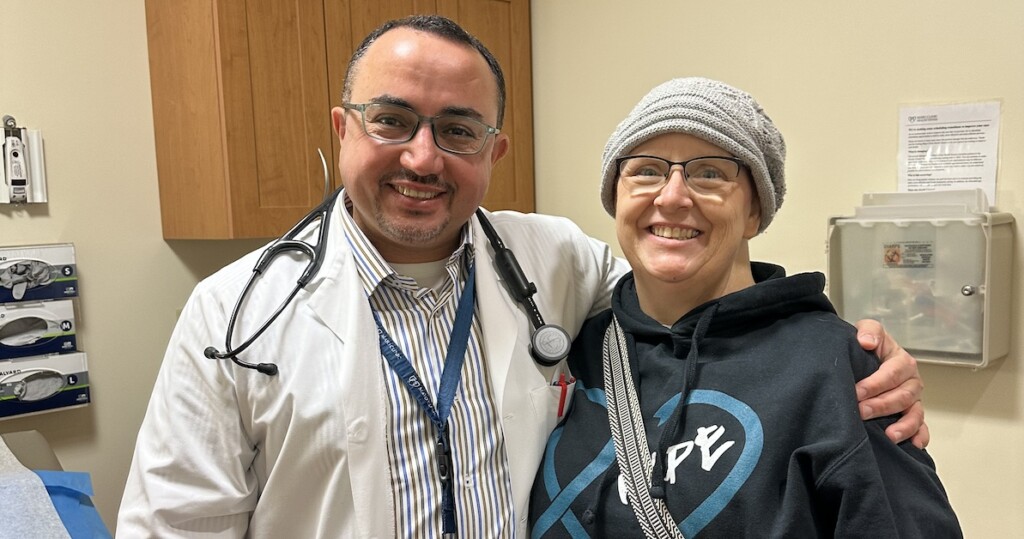
Find a Doctor
Locate gynecologic oncologists, specialists, and treatment centers in your area.
If a doctor suspects ovarian cancer, they may perform tests such as a pelvic exam, transvaginal ultrasound, CT scan, or CA-125 blood test to learn more. It is important to know, however, that none of these tests are definitive on their own. A surgical biopsy is the only way to make a definitive diagnosis of ovarian cancer.
Though symptoms are often what lead an individual to pursue an ovarian cancer diagnosis, it’s important to know that not everyone with ovarian cancer experiences symptoms and the most common symptoms are not unique to ovarian cancer. Common symptoms may include bloating, pelvic pain, feeling full quickly, and urinary symptoms; however, these can overlap with less serious conditions. Family history and risk factors should also be discussed with your physician in conversations about ovarian cancer.
To learn more about ovarian cancer signs and symptoms, visit our dedicated page.
Annual check-ups and pelvic exams are useful for general reproductive health but usually do not detect ovarian tumors, which are often too small. Ovarian cancer also cannot be diagnosed through a Pap smear, which only screens for cervical cancer.
If ovarian cancer is suspected, doctors may conduct blood work or order imaging tests like transvaginal ultrasounds or CT scans. However, a surgical biopsy is the only definitive way to diagnose ovarian cancer.
If you notice persistent symptoms or have concerns about your ovarian cancer risk, we encourage you to speak with your doctor promptly. Early discussions can help guide necessary steps and provide peace of mind.
Ovarian cancer is rarely detected during routine physical or gynecologic exams due to its location deep in the body. Without an early detection tool, tumors are usually only found when they are large and more advanced. However, routine physical or gynecologic exams are crucial as initial steps that can lead to more detailed imaging tests and surgical procedures.
It’s also important to ask your doctor about genetic counseling and testing, which can help identify if you are high-risk. If you’re concerned about your risk or experiencing symptoms, schedule an exam and discuss your concerns about ovarian cancer with your doctor.
Doctors may order imaging tests for detecting ovarian cancer, such as a CT scan or transvaginal ultrasound, if they suspect the disease. These tests help identify masses in the ovaries or pelvic area and assess whether they might be malignant. However, imaging tests alone cannot confirm an ovarian cancer diagnosis.
CT scans employ x-rays to take multiple cross-sectional images of the tissues and bones in the body. Doctors can analyze the images or use software to make a three-dimensional model of the internal organs. A CT scan can define the boundaries of a tumor and show the extent of tumor spread, helping a doctor determine where to operate.
An x-ray produces cross-body imaging using a type of radiation called electromagnetic waves. X-rays are rarely used in diagnosing ovarian cancer, but they are sometimes used to see if cancer has spread elsewhere in the body. A chest x-ray can display tumors in the lungs and fluid that has collected near the lungs, known as pleural effusion.
An MRI, short for magnetic resonance imaging, is similar to an X-ray, except it does not use radiation. An MRI uses magnetic radio waves to produce images of the inside of the body. MRIs are rarely used to check for ovarian cancer initially, though they can be used to examine the spinal cord and the brain, where cancer can sometimes spread.
A surgical biopsy is the only way to definitively diagnose ovarian cancer. In some cases, a minimally invasive surgery (laparoscopy or robotic surgery) may be performed first to confirm a diagnosis with biopsy and to determine whether to proceed with a full cancer resection or to administer chemotherapy first.
In a laparoscopy or robotic surgery, a physician can examine the ovaries and other pelvic and abdominal organs using a camera inserted through a small incision in the abdominal wall. Both approaches to minimally invasive surgery can determine how large the tumors have grown and whether they can be completely resected. These procedures allow the surgeon to perform a biopsy to confirm the diagnosis and to collect more information about the tumor that may guide treatment decisions.
The only way to definitively determine if a patient has ovarian cancer is through a biopsy. This is when tissues from a tumor are removed and tested in a lab. A laparoscopy may be performed to evaluate tumor spread and collect tissue for a diagnosis, or a diagnosis may be made by sampling tissue during a more extensive surgery to fully resect the cancer. In some cases, a biopsy may be performed using image guidance with a CT scan or ultrasound.
No single blood test can diagnose ovarian cancer. However, certain tests can help estimate risk, or monitor its progression. Below is an overview of key tests used in the evaluation process.
Purpose: Measures levels of five proteins that may change when ovarian cancer is present.
Usage: Helps determine if surgery should be done by a gynecologic oncologist. Not a screening tool, and does not provide definitive evidence of cancer.
Purpose: May help detect and monitor granulosa cell tumors.
Usage: Assesses risk of presence and progression of these specific tumors.
Purpose: CA-125 blood test, or “Cancer Antigen 125” is a test that measures a protein that is elevated in more than 80% of advanced ovarian cancers and 50% of early-stage cancers.
Usage: Useful for monitoring the response to treatment or for evidence of cancer recurrence but not recommended as a general screening tool due to the fact that it can often be elevated in benign or unrelated conditions.
Doctors frequently order a CA-125 test when they are concerned that a woman may have ovarian cancer. Because CA-125 levels can fluctuate in response to treatment, the test is also used to monitor how well treatment is working or if alternative treatment should be considered. CA-125 is also frequently used to monitor for recurrence. With evidence that monitoring CA-125 may not impact overall survival, some patients or providers may elect not to follow this marker. Read an article on CA-125 usage.
No, a high CA-125 does not always mean cancer is present. Generally speaking, the normal range of CA-125 is considered to be 0-35 units/mL, while a level above 35 units/mL is considered to be a high CA-125 level. Although a CA-125 blood test can be a useful tool for the diagnosis of ovarian cancer, it is not uncommon for a CA-125 count to be elevated in premenopausal women due to benign conditions since it fluctuates as part of their normal menstrual cycle, or due to benign conditions unrelated to ovarian cancer, such as diverticulitis, endometriosis, liver cirrhosis, pregnancy, or uterine fibroids, as Medscape details here. As a result, the CA-125 is generally only one of several tools used to help diagnose ovarian cancer in a patient with a pelvic mass or other suspicious clinical findings.
There is no evidence to suggest that doing so is beneficial. The CA-125 test is most helpful in postmenopausal women with a pelvic mass. It is also important to note that in about 20 percent of cases of advanced stage disease, and 50 percent of cases of early stage disease, CA-125 is NOT elevated, even though there is ovarian cancer present — and CA-125 can also be elevated by benign conditions. For these reasons, the National Cancer Institute and the United States Preventive Services Task Force do not endorse using it to screen women for ovarian cancer who are at ordinary risk or in the general population. Learn more about their recommendations around CA-125 and screening.
For those undergoing ovarian cancer treatment, CA-125 levels may fluctuate based on treatment response, with lower levels indicating the treatment is working. As mentioned above, CA-125 can also fluctuate because of benign or unrelated conditions — including uterine fibroids, endometriosis, diverticulitis, liver cirrhosis, or pregnancy.
Studies have shown that annual screening with CA-125 tests and transvaginal ultrasounds for average-risk women does not improve survival rates and may lead to unnecessary surgeries, which can increase the risk of complications. The UK Collaborative Trial of Ovarian Cancer Screening (UKCTOCS) found that this approach failed to prevent deaths from ovarian cancer.
The ROCA Test uses changes in CA-125 levels over time, along with factors like age and menopausal status, to predict ovarian cancer risk. It is marketed as part of an annual check-up, costing $295, but there is no evidence it prevents deaths from ovarian cancer. The FDA issued a Safety Guidance in 2016 highlighting potential risks of ovarian cancer screening tests, including the ROCA Test, which is not FDA approved.

Locate gynecologic oncologists, specialists, and treatment centers in your area.

Learn about the factors that contribute to ovarian cancer risk and explore prevention strategies to reduce your risk.

Recognizing the interconnectedness of ovarian and all gynecologic cancers, OCRA expanded its scope in order to accelerate research and broaden our impact on patients’ lives.
Get email updates about research news, action alerts, and ways to join the fight.